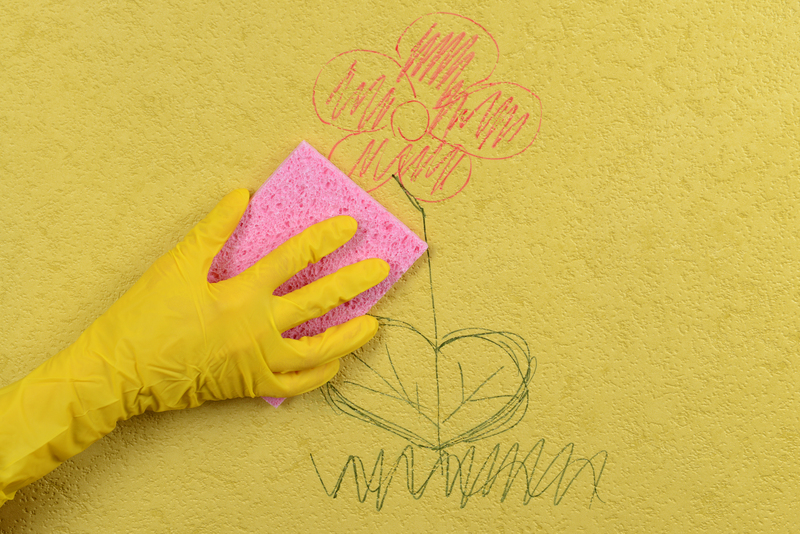Discover Secrets to a Residue-free Stovetop Surface
Posted on 12/09/2025
Discover Secrets to a Residue-free Stovetop Surface
Are you searching for the best ways to maintain a spotless, residue-free stovetop surface? Many homeowners and cooking enthusiasts struggle with stubborn grime, grease, and streaks that seem impossible to remove. Worry no more! We've put together a comprehensive, SEO-optimized guide that unlocks professional secrets to achieving a pristine stovetop--without harsh chemicals or endless scrubbing.

Why a Spotless, Residue-Free Stovetop Matters
Keeping your stovetop surface residue-free isn't just about aesthetics. A clean cooking surface ensures better hygiene, enhances kitchen safety by reducing fire hazards, and extends the lifespan of your appliance. More importantly, preparing meals on a clean stove preserves the flavors of your culinary creations, as residue and build-up can negatively affect the taste of food.
Main Types of Stovetop Surfaces
Before diving into the best methods and tips, it's important to identify your stovetop type. Each surface requires specific cleaning techniques to ensure it remains spotless and residue-free.
- Gas Stovetop: Features removable grates and burners, easy to clean but prone to grease splatter.
- Electric Coil Stove: Simple design; coils can build up residue and may need to be removed for a thorough cleaning.
- Glass/Ceramic Stovetop: Sleek, modern, but scratches and streaks easily; requires gentle touch and suitable products.
- Induction Cooktop: Flat glass surface, similar to ceramic, but with distinct cleaning needs to prevent film or cloudy spots.
Common Causes of Stovetop Residue
Understanding what leads to residue buildup is the first step in prevention and effective cleaning:
- Spills and Overflows: Boiling liquids, oils, or sauces spilling over onto the cooking surface.
- Grease Splash: Frying or sauteing without a lid can lead to pervasive grease spots.
- Improper Cleaning Products: Industrial cleaners or abrasive sponges can leave behind film or micro-scratches.
- Burnt-on Food: Food particles and sugars left to cook onto the surface form hard, sticky residue.
- Mineral Deposits: Tap water can leave minerals on certain stovetops, especially glass or induction surfaces.
Essential Tools for a Residue-free Stovetop Surface
Comprehensive stove maintenance requires a few key tools. Stock your cleaning kit with these essentials to streamline your efforts and achieve a residue-free stove top every time:
- Microfiber Cloths: Ultra-absorbent, soft, and traps grease without leaving lint.
- Non-abrasive Sponges: Prevent scratches and allow gentle scrubbing of cooked-on debris.
- Plastic Razor Blades or Scrapers: Safe for glass or ceramic stovetops--ideal for lifting stubborn residue.
- Baking Soda: Natural abrasive and deodorizer that's safe for most surfaces.
- White Vinegar: Cuts through grease and dissolves mineral deposits.
- Dedicated Stovetop Cleaner: Consider non-toxic options formulated for your specific stovetop type.
- Spray Bottles: For making custom, eco-friendly cleaning solutions.
- Old Toothbrush: Perfect for cleaning crevices and knobs.
Step-by-Step Secrets to a Residue-free Stove Top
Elevate your cleaning routine with this proven, step-by-step method for a truly residue-free stove surface. These tips cover gas, electric, ceramic, induction, and glass stovetops to ensure your kitchen shines.
1. Preparation - Let It Cool and Remove Components
- Safety first! Always make sure your stove is completely cool to avoid burns.
- Remove grates, burner caps, or electric coils where applicable.
- Wipe off loose crumbs and debris with a dry microfiber cloth.
2. Initial Degreasing - The Foundation of a Gleaming Stove Top
- Mix equal parts of white vinegar and water in a spray bottle.
- Spray generously over the stovetop surface.
- Let it sit for 3-5 minutes to loosen up grease and light residue.
- Wipe with a clean microfiber cloth in a circular motion.
3. Scrub Away Stubborn Residue - Baking Soda Magic
- Sprinkle baking soda over tough, burnt-on spots.
- Spritz with vinegar-water solution (it will fizz up, aiding in loosening build-up).
- Use a soft sponge or plastic scraper to gently work out the residue.
- For glass or ceramic stovetops, avoid harsh scouring pads.
4. Rinse, Wipe, and Dry - Removing All Traces of Cleaner
- Dampen a clean cloth with distilled water and wipe down the entire surface.
- Ensure all baking soda or cleaning solution is thoroughly rinsed away.
- Dry with a fresh, dry microfiber towel to prevent water spots and streaks.
5. Deep Clean Burners and Grates
- Soak metal grates and caps in warm, soapy water for 10-20 minutes.
- Scrub gently with an old toothbrush or soft cloth.
- For persistent residue, form a paste using baking soda and water, apply, let sit, then scrub.
- Allow to air dry completely before replacing on the stove.
6. Polish and Shine - Achieve That Professional Finish
- Rub a small amount of glass cleaner or a diluted vinegar and water mix for a streak-free gloss.
- Buff with a clean, dry microfiber cloth.
- For gas stove tops, ensure the surface is dry before reigniting burners.
Secret Hacks for a Residue-free Cooktop Surface
- Immediate Spot Cleaning: Clean up spills as soon as it's safe--fresh residue wipes away easily.
- Protective Covers: Use reusable silicone covers on burners or stove liners to catch drips and crumbs.
- Lemon Power: A halved lemon sprinkled with baking soda gently scrubs away odors and stains while leaving a fresh scent.
- Steam Trick: Place a bowl of boiling water on an electric or induction stovetop (when off). The steam loosens sticky residue for easier removal.
- Clay Bar: Specialty automotive clay bars can lift stubborn deposits from glass cooktops.
Ingredients to Avoid on Your Stove Top
A residue-free stove surface is only achievable if you steer clear of products that can cause more harm than good:
- Abrasive Scouring Pads: These scratch the surface and leave micro-grooves that collect grime.
- Ammonia-based Cleaners: Can discolor or damage surface finishes, especially on glass and ceramic stoves.
- Bleach: Harsh and can corrode metal or glass elements.
- Powdered Cleansers (with grit): Use baking soda instead, as it's less abrasive.
- Open-flame on Glass/Ceramic: Never use open flame to try to "burn off" residue; it will permanently damage the surface.
Routine Maintenance for a Pristine, Residue-free Stove Top
The secret to an eternally clean cooktop lies in consistency. Just a few minutes of daily care makes deep cleaning infrequent and effortless.
Daily Habits to Adopt
- Wipe down the surface after every use with a damp microfiber cloth.
- Remove burner grates and clean under them weekly to avoid hidden build-up.
- Keep a spray bottle of vinegar-water handy for quick degreasing.
- Immediately address spills--don't let them bake onto the cooktop!
Weekly & Monthly Cleaning Routine
- Deep clean grates, drip pans, and burner caps weekly.
- Use a stovetop cleaner for glass or induction models once a week to maintain a streak-free shine.
- Inspect seals, knobs, and crevices monthly for hidden gunk.
- Polish the surface to maintain that just-like-new look.
Professional Tips for Stubborn, Burnt-On Residue
Even with the best intentions, sometimes spills get burnt onto your stovetop. Here's how to reclaim your surface:
- Soak Method: Lay a wet towel over the burnt area for 15 minutes to soften charred residue before cleaning.
- Plastic Razor or Scraper: Carefully angle under the residue and slide away, taking care not to scratch glass or ceramic surfaces.
- Paste Application: Mix baking soda and a few drops of water into a thick paste; apply, wait 30 minutes, and gently scrub.
- Commercial Cream Cleansers: For glass cooktops, a non-abrasive cream cleaner can erase stubborn marks.
Eco-Friendly Strategies for a Residue-free Stove Top
Minimize your ecological impact with green solutions:
- Baking Soda & Vinegar: Natural, effective, and safe for most stove top materials.
- Lemon Juice: Natural degreaser and deodorizer.
- Reusable Cloths: Avoid waste from paper towels by using washable microfiber or cotton rags.
- Homemade Cleaners: Mix two tablespoons of dish soap, a half-cup of white vinegar, and two cups hot water for an all-purpose degreaser.

Frequently Asked Questions About Residue-free Stove Top Cleaning
Can I use vinegar on all stove types?
Vinegar is generally safe for gas, electric, and glass-ceramic stovetops. However, always check your manufacturer's recommendations for induction or specialty coated surfaces.
What if I scratch my glass cooktop?
Minor scratches can be minimized with specialty glass polishers, but deep scratches are permanent. Prevention by using non-abrasive tools is essential.
How often should I clean my stove for best results?
For a truly residue-free stove top, aim for quick spot cleaning after each use and a deeper clean weekly.
Are store-bought cleaners safe?
Many commercial cleaners work well but read labels--choose those free of ammonia, bleach, and abrasive compounds to avoid residue and damage.
Conclusion - Achieve a Sparkling, Residue-free Stovetop Surface Every Time
Maintaining a residue-free stovetop surface is easier than you think with the right knowledge and resources. Choose the correct cleaning products, use non-abrasive tools, and follow our step-by-step routine to effortlessly keep your stove looking new. Remember, regular maintenance is key--adopt quick daily habits to enjoy a brilliant, hygienic, and safe cooking environment. Your journey to a flawless stove top starts today!



